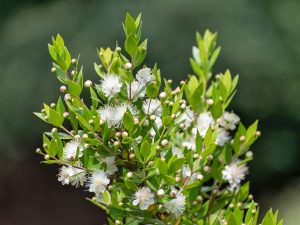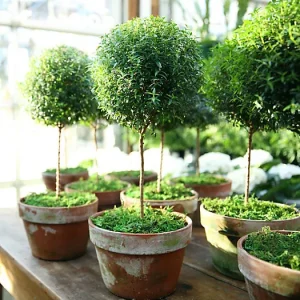Myrtle – Botany

Myrtus, with the common name myrtle, is a genus of flowering plants in the family Myrtaceae
The genus Myrtus has three species recognised today:
- Myrtus communis – Common myrtle; native to the Mediterranean region in southern Europe.
- Myrtus nivellei – Saharan myrtle; native to North Africa.
- Myrtus phyllireaefolia
In the garden
Myrtus communis is widely cultivated as an ornamental plant for use as a shrub in gardens and parks. It is often used as a hedge plant, with its small leaves shearing cleanly.
The plant is an evergreen shrub or small tree, growing to 5 metres (16 ft) tall. The leaf is entire, 3–5 mm long, with fragrant essential oil. Star-like flowers have five petals and sepals, and numerous stamens. Petals usually are white. The flower is pollinated by insects. The fruit is a round berry containing several seeds, most common blue-black in colour. A variety with yellow-amber berries is also present. The seeds are dispersed by birds that eat the berries.
When trimmed less frequently, it has numerous flowers in late summer. It requires a long hot summer to produce its flowers, and protection from winter frosts.
Mini-myrtle topiary trees

Adriaan shows us how to create mini-myrtle Mother’s Day topiaries. For these, we used dwarf myrtle. Creating mini-topiary trees are much the same as creating for creating larger topiaries. It entails trimming the stem, training the plant on a stake and shaping the head.
For these mini-topiaries rather use a sharp old-school razor blade than sheers or a pair of scissors as these blades would be too large. You can simply use a chopstick to stake your topiary around.
Adriaan used little terracotta pots to plant the topiaries in. However, you can use any pot with proper drainage. You can use regular potting soil. To determine how much soil you will need to place in the bottom of the pot, check the level of the stem against a spot about 1cm below the rim of the pot. For larger plants in pots, this distance can be increased.
Lift the tree gently from the original plastic pot, place it in the terracotta pot, fill the rest of the pot with soil and press down gently. Be sure to water the tree regularly, remembering that the smaller the pot the faster it will dry out. If placed outside add a thin layer of mulch.
As the tree grows continue to shear any new growth from the lower part of the stem and re-stake the tree as needed. As the head of the topiary grows larger you can begin to shape it with a sharp pair of scissors or bonsai shears.
Culinary Use
Use myrtle leaves whole or chopped for flavour ring soups and stews similarly to bay leaves. The leaves have spicy, astringent, and bitter taste with a refreshing, fragrant, and orange like aroma. Lemon myrtle has a refreshing aroma and taste.
The seeds are purple-black berries. These you can use whole or coarsely ground.
Myrtle berries are also highly edible, with a fruity, slightly astringent flavour. These go particularly well with enhancing chicken, fish and meat dishes. You can use them to make jam (usually combined with other fruit) or. One can use the berries steeped in alcohol and sweetened with honey to make a unique-flavoured beverage as in the Sardinian tradition.

How to grow Myrtle
For the best results, plant myrtle outdoors in late spring in a well-drained, sheltered position. This gives it the best chance of establishing a good root system before winter weather sets in.
Myrtle is a plant native to the Mediterranean area, it therefore it finds cold weather unbearable, especially over long periods of time. So, if you are living in frost-prone areas of South Africa make sure that you cover yours with frost cover during winter or move potted one’s to sheltered areas.
It’s preferable to plant common myrtle in autumn to favour root development and renewed growth in spring. It is also possible to plant common myrtle in spring but then you must be in a position to water it all summer long during the first year after you’ve planted.
- Common myrtle prefers locations with high exposure to sunlight.
- It likes rich and well-drained soil, that is where it flowers best.
- Adding soil conditioner when planting enhances settling in and root development.
- Water well during the first 2 years after planting.
- Avoid overwatering the plant; it often develops yellow leaves if the soil is excessively wet.
Common myrtle in pots and containers
You can also plant common myrtle in pots outside as long as you avoid both below-freezing temperatures and excessively hot weather.
Potted common myrtle is ideal for regions where winters are harsh, as it can be moved around.
Water and feed with a potash-rich tomato food during the growing season. The potash will encourage more flower and also harden the wood. Ease off watering from late February (Southern hemisphere) onwards, then dry off almost completely before over-wintering the container. Then place in a protected spot
Health uses
Myrtle has some highly effective antimicrobial, anti-inflammatory and astringent qualities, which makes it valuable in the treatment of many respiratory ailments and skin issues. The plant contains high levels of salicylic acid (a compound related to aspirin) and is an expectorant (helps to get rid of mucus), which makes myrtle tea an excellent choice for colds and flu.
References
https://en.wikipedia.org/wiki/Myrtus
https://www.nature-and-garden.com/gardening/common-myrtle.html
https://www.telegraph.co.uk/gardening/howtogrow/3346354/Myrtle-How-to-grow.html
https://www.motherearthnews.com/natural-health/myrtle-medicinal-and-culinary-properties-zbcz1612
http://theepicentre.com/spice/myrtle/
